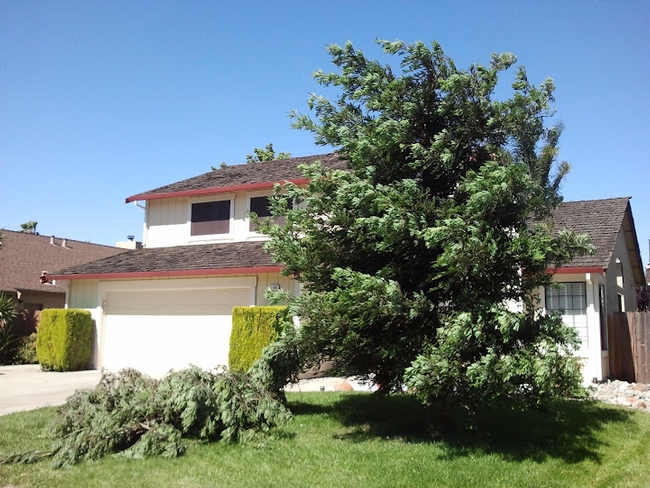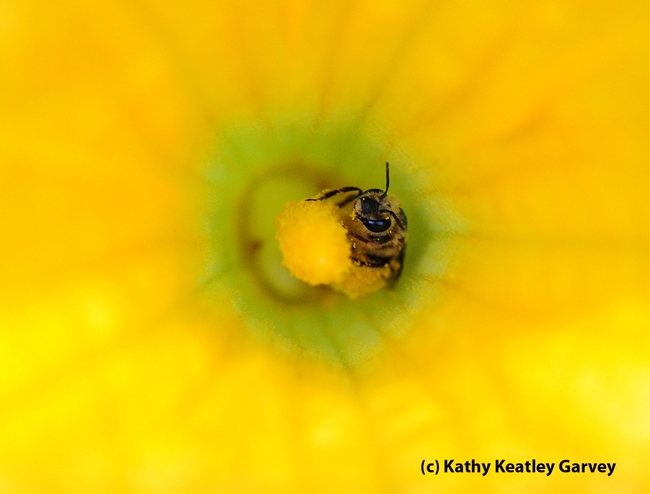UC Blogs
Off to Italy on a Very Important Mission
It won't be lock, stock and barrel, but it will be stock. A team of scientists from UC Davis and Washington State University will be heading for...

Italian honey bee heading toward lavender. (Photo by Kathy Keatley Garvey)
Redwood Damage
The winds of late spring are an uncomfortable reality in Solano County. They blew through on June 8 and 9, blustery, drying north winds that disrupted graduation ceremonies, outdoor weddings and picnics at the park. Broken tree branches and piles of leaves and twigs, pushed up against north-facing fences and gutters, were evidence of the onslaught.
A realist would shrug off the loss of large branches as Mother Nature’s rather brutal pruning plan. Sometimes that’s a hard pill to swallow. A friend of ours lost the top third of a redwood tree planted in his front-yard lawn. When I heard this, I immediately thought of another friend who had recently told me about losing the top portion of a redwood tree on her property. Turns out, that loss was due to lack of water, but both of my friends now face a tricky situation: What do you do with a fast-growing evergreen that loses its terminal bud leader?
Redwoods that have been topped — whether by nature or humans — tend to freak out, sprouting from masses of dormant buds just below the topping cut and under the bark. This results in an extremely fast-growing tangled mess of unstable branches where once there was one tidy and elegant trunk. These masses are weak and tend to peel away in strong winds (which we know will return in late spring).
What my friends now face is quite possibly annual pruning of those redwoods. They must be prepared to maintain the sprouts and trim any large branches regularly. And they should consult with a certified arborist to do this work.
Redwood trees are considered to be wind-resistant trees. It appears my friend’s front-yard tree, though robust and healthy in appearance, faced prior stress and had become weakened somewhere along the way. Leave it to the winds of late spring to test that stress. Maybe it’s Mother Nature’s pruning plan after all.

Late spring’s strong north winds caused this otherwise healthy redwood tree to lose its leader. The tree is located in southeast Vacaville. (photo by Ken Williams)
Master Gardeners build low-water demo garden
Over the past year, volunteers in the University of California Cooperative Extension Ventura County Master Gardeners program have transformed space next to the Goebel Senior Adult Center in Thousand Oaks into a living showcase of native, drought-tolerant plants and sustainable garden concepts, said an article in the Ventura County Star.
The "California True Colors Garden and Learning Center" contains a collection of 200 desert plants such as the Palo Verde tree, desert grasses and the violet-flowered foothill penstemon growing along meandering paths and dry pond bed.
"These are tough plants. We don't feed them, we hardly water them, but look how beautiful they are," said Master Gardener Fayde Macune. "They do well with very little care."
Jim Downer, UC Cooperative Extension advisor in Ventura County, said the garden also has a research component. Forty plants are "Arboretum All-Stars" — specimens provided by UC Davis that are proven to be low maintenance, drought-tolerant and attractive to beneficial wildlife such as pollinating insects. Others will be trial plants.
More information and directions to the garden.

The dry pond (right) at the California True Colors Garden and Learning Center.
Applause for the Pollinators
Let's have a pause--and applause--for the pollinators. Next week, June 18-24, is National Pollinator Week, as designated by the U.S. Department of...

ORNAMENTAL--A bumble bee visiting a rock purslane. (Photo by Kathy Keatley Garvey)

VEGETABLE--A squash bee nestled in a squash blossom. (Photo by Kathy Keatley Garvey)

FRUIT--Honey bees battling over a pomegranate blossom. (Photo by Kathy Keatley Garvey)
Grasshopper BOLO (Be On the Look Out)
Just this week it was announced by the Solano County Agriculture Commissioner, Jim Allan, that the northwest portion of Solano County is being inundated with grass hoppers. The area under attack is from Cherry Glen to the county line. There are people reporting the presence of a large number of grasshoppers eating their plants. Samples of the pest were taken for identification, but it's thought these grass hoppers are the Devastating Grasshopper or another grass hopper that is closely related.
So far, the pests aren't bothering the farm crops, but unfortunately are causing significant damage to homeowners plants. Grass hoppers will basically eat any plant that is in their wake.
The grass hopper is difficult to control, and only licensed professionals can use the pesticides that might control them. It's basically turned into a waiting game until they are done with their life cycle. There is more information on the UC IPM (UC Integrated Pest Management) website about grass hoppers, click here for that information. Here is a link to a printable handout with information about the biology and control of the pest.
So be on the lookout for this pest and good luck!

Grasshopper found in Pleasants Valley. (photos by Jim Allan)

Yucca ravaged by grass hoppers.

